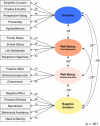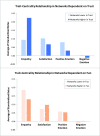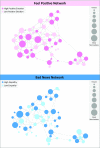Empathy and well-being correlate with centrality in different social networks
- PMID: 28851835
- PMCID: PMC5604000
- DOI: 10.1073/pnas.1702155114
Empathy and well-being correlate with centrality in different social networks
Abstract
Individuals benefit from occupying central roles in social networks, but little is known about the psychological traits that predict centrality. Across four college freshman dorms (n = 193), we characterized individuals with a battery of personality questionnaires and also asked them to nominate dorm members with whom they had different types of relationships. This revealed several social networks within dorm communities with differing characteristics. In particular, additional data showed that networks varied in the degree to which nominations depend on (i) trust and (ii) shared fun and excitement. Networks more dependent upon trust were further defined by fewer connections than those more dependent on fun. Crucially, network and personality features interacted to predict individuals' centrality: people high in well-being (i.e., life satisfaction and positive emotion) were central to networks characterized by fun, whereas people high in empathy were central to networks characterized by trust. Together, these findings provide network-based corroboration of psychological evidence that well-being is socially attractive, whereas empathy supports close relationships. More broadly, these data highlight how an individual's personality relates to the roles that they play in sustaining their community.
Keywords: centrality; empathy; personality; social networks; well-being.
Conflict of interest statement
The authors declare no conflict of interest.
Figures



Similar articles
-
An examination of the perceptions of social network characteristics associated with grandiose and vulnerable narcissism.Personal Disord. 2014 Apr;5(2):137-145. doi: 10.1037/per0000024. Epub 2013 Dec 23. Personal Disord. 2014. PMID: 24364501
-
Neural detection of socially valued community members.Proc Natl Acad Sci U S A. 2018 Aug 7;115(32):8149-8154. doi: 10.1073/pnas.1712811115. Epub 2018 Jul 23. Proc Natl Acad Sci U S A. 2018. PMID: 30038007 Free PMC article.
-
The social-cognitive basis of personality disorders.Curr Opin Psychiatry. 2014 Jan;27(1):73-7. doi: 10.1097/YCO.0000000000000026. Curr Opin Psychiatry. 2014. PMID: 24270477 Review.
-
Variability in personality expression across contexts: a social network approach.J Pers. 2014 Apr;82(2):103-15. doi: 10.1111/jopy.12038. Epub 2013 May 9. J Pers. 2014. PMID: 23551024
-
The Social Salience Hypothesis of Oxytocin.Biol Psychiatry. 2016 Feb 1;79(3):194-202. doi: 10.1016/j.biopsych.2015.07.020. Epub 2015 Aug 5. Biol Psychiatry. 2016. PMID: 26321019 Review.
Cited by
-
Thought Control Ability Moderates the Effect of Mind Wandering on Positive Affect via the Frontoparietal Control Network.Front Psychol. 2019 Jan 25;9:2791. doi: 10.3389/fpsyg.2018.02791. eCollection 2018. Front Psychol. 2019. PMID: 30740082 Free PMC article.
-
Proximity within adolescent peer networks predicts neural similarity during affective experience.Soc Cogn Affect Neurosci. 2024 Nov 5;19(1):nsae072. doi: 10.1093/scan/nsae072. Soc Cogn Affect Neurosci. 2024. PMID: 39412190 Free PMC article.
-
Social microclimates and well-being.Emotion. 2024 Apr;24(3):836-846. doi: 10.1037/emo0001277. Epub 2023 Oct 12. Emotion. 2024. PMID: 37824222 Free PMC article.
-
Examining the Effects of a Brief, Fully Self-Guided Mindfulness Ecological Momentary Intervention on Empathy and Theory-of-Mind for Generalized Anxiety Disorder: Randomized Controlled Trial.JMIR Ment Health. 2024 May 24;11:e54412. doi: 10.2196/54412. JMIR Ment Health. 2024. PMID: 38787613 Free PMC article. Clinical Trial.
-
The mediating role of psychological capital on the relation between distress and empathy of medical residents: a cross-sectional survey.Med Educ Online. 2020 Dec;25(1):1710326. doi: 10.1080/10872981.2019.1710326. Med Educ Online. 2020. PMID: 31900104 Free PMC article.
References
-
- Jackson MO. Social and Economic Networks. Princeton Univ Press; Princeton: 2008.
-
- Klein KJ, Lim B-C, Saltz JL, Mayer DM. How do they get there? An examination of the antecedents of centrality in team networks. Acad Manage J. 2004;47:952–963.
-
- Kilduff M, Krackhardt D. Bringing the individual back in: A structural analysis of the internal market for reputation in organizations. Acad Manage J. 1994;37:87–108.
-
- Hanneman RA, Riddle M. Introduction to Social Network Methods. University of California; Riverside, CA: 2005.
-
- Taylor SE. Oxford Handbook of Health Psychology. Oxford Univ Press; New York: 2010. Social support: A review.
Publication types
MeSH terms
Grants and funding
LinkOut - more resources
Full Text Sources
Other Literature Sources

